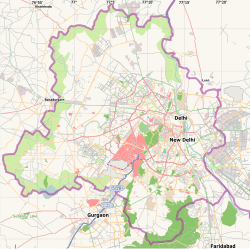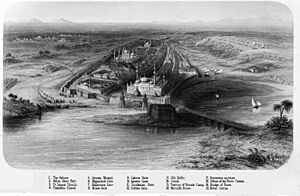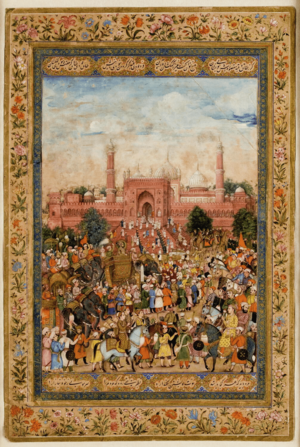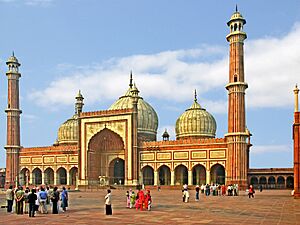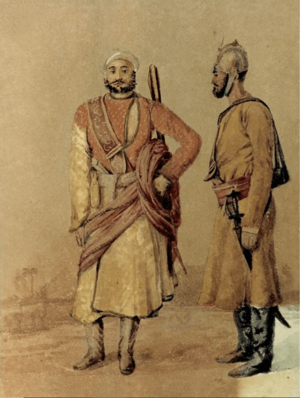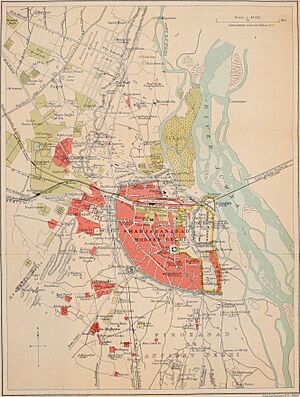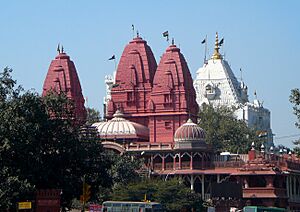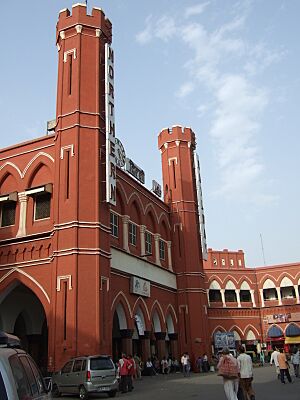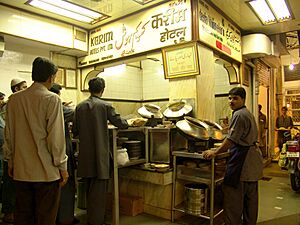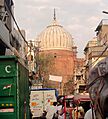Old Delhi facts for kids
Quick facts for kids
Old Delhi
Purani Dilli
|
|
|---|---|
|
Municipality
|
|

|
|
| Country | |
| Union Territory | Delhi |
| District | Central Delhi |
| Founded by | Shah Jahan |
Old Delhi (also known as Purani Dilli) is a historic part of Delhi, India. It was built as a walled city named Shahjahanabad in 1648. This happened when the Mughal emperor Shah Jahan decided to move his capital from Agra to this new city.
Old Delhi was the capital of the Mughal Empire until 1857. That's when the British Empire took control of India. Today, Old Delhi is like the heart of modern Delhi. It is famous for its lively markets, delicious street food, and beautiful Islamic buildings. The Jama Masjid is a great example, standing tall in the middle of the old city.
Contents
Discovering Old Delhi's Past
Old Delhi has a very long and interesting history. Before Shahjahanabad was built, other cities of Delhi stood nearby.
Early Rulers: The Delhi Sultanates
The area where Old Delhi stands today was close to earlier settlements. These were ruled by different groups called the Delhi Sultanates. They ruled from Delhi between 1206 and 1526. There were five main dynasties, or ruling families, during this time.
The Mughal Empire's Capital
Delhi was very important to the Mughal dynasty. They built many grand palaces and forts here. The most famous Mughal emperor, Shah Jahan, ordered his architect, Ustad Ahmad Lahori, to build the walled city of Shahjahanabad. This construction took place between 1638 and 1649. It included the mighty Lal Qila (Red Fort) and the famous market, Chandni Chowk.
In 1648, Shahjahanabad became one of the main provinces of the Mughal Empire. The first wholesale market in Old Delhi opened in Chawri Bazaar in 1840. Another big market for spices and herbs, Khari Baoli, opened in 1850. Even today, these markets are very busy and important.
British Rule and New Delhi
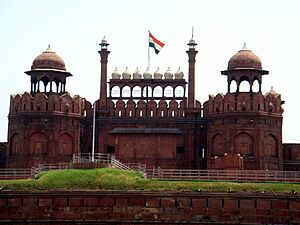
After a big revolt in 1857, the British Raj took over. They moved their capital from Delhi to Calcutta (now Kolkata). But in 1911, they decided to move the capital back to Delhi. They built a new city, Lutyens' Delhi, right next to Shahjahanabad. This new area is now called New Delhi.
Because of this, the older city started being called Old Delhi. New Delhi officially became the capital in 1931.
What Old Delhi Looked Like in 1876
In 1876, a writer named Carr Stephen described Old Delhi. He said there were two main streets. One went from the city's Lahore Gate to the Red Fort's Lahore Gate. The other went from the city's Delhi Gate to the fort's Lahore Gate.
These streets had different sections. For example, there was the Urdu Bazaar, where soldiers might have been. Then came the Phul ka Mandi, which was a flower market. Further along was the Jauhari Bazaar for jewelers. The most famous part was the Chandni Chowk. It used to have a tank (a water pool) in the middle, where a clock tower stands today.
The houses around Chandni Chowk were all the same height and had beautiful arched doors. This grand street was designed by Jahanara Begum, Shah Jahan's daughter. A canal once ran through the middle of Chandni Chowk, with trees shading both sides.
Today, the clock tower is gone, but the area is still called Ghantaghar.
Who Lives in Old Delhi?
After the city was built, many people came to Old Delhi looking for jobs and a better life. They came from different parts of India like Rajasthan, Punjab, and Uttar Pradesh. This is why the people of Old Delhi are a mix of many different groups from across India. Most people speak Hindi–Urdu.
Old Delhi's Walls and Gates

Old Delhi was shaped like a quarter circle, with the Red Fort at its center. The old city was surrounded by a strong wall. This wall was about 12 feet wide and 26 feet tall. It was first made of mud but was rebuilt with red stone in 1657.
The wall had 14 gates. Some of the important gates were:
- Kashmiri Gate: in the north.
- Lahori Gate: in the west, near the railway station.
- Ajmeri Gate: in the southwest, leading towards New Delhi.
- Turkman Gate: also in the southwest.
- Delhi Gate: in the south, leading to older parts of Delhi.
During the Mughal period, these gates were locked at night for safety. Most of the walls are gone now, but many of the gates still stand. You can still see the shape of the old city from a satellite image because of how closely the houses are built.
Famous Streets and Areas
The main street of Old Delhi is Chandni Chowk. It stretches from the Red Fort to Fatehpuri Masjid. A canal used to run through the middle of this street.
- Dariba Kalan is a busy residential area south of Chandni Chowk.
- Daryaganj used to be next to the Yamuna River.
- The Urdu language actually grew popular in the Urdu Bazaar section of Old Delhi.
The main roads that go through Old Delhi are:
- Netaji Subhash Marg / Bahadur Shah Zafar Marg (north and south)
- Chandni Chowk/Khari Bawli Road (east and west)
Old Delhi is roughly surrounded by these modern roads:
- Nicholson Road (north)
- Mahatma Gandhi Marg (east)
- Shraddhananda Marg (west)
- Jawaharlal Nehru Marg (south)
Important Historical Places
Many of Old Delhi's historical sites are in the Chandni Chowk area and around the Red Fort. Here are some other important places:
- Gurudwara Sis Ganj Sahib: This is a Sikh temple built to remember Guru Tegh Bahadur. He was a Sikh Guru who was executed here in 1675 for standing up against forced religious conversions.
- Jama Masjid: This is India's largest mosque.
- Lal Mandir: Delhi's oldest Jain temple.
- Khari Baoli: Asia's biggest spice market.
- Rajghat: This is a memorial for Mahatma Gandhi, where he was cremated.
- St. James Church: Built in 1836, it is Delhi's oldest church.
Some famous old mansions (called havelis) include:
- Mirza Ghalib's haveli in Gali Qasim Jan.
- Chunnamal haveli in Katra Neel.
- Haksar Haveli, where Jawaharlal Nehru was married in 1916.
- Haveli Naharwali, where Pervez Musharraf, a former president of Pakistan, was born.
Delicious Food in Old Delhi
Old Delhi is very famous for its amazing food. Because it was the capital of the Mughal Empire for a long time, it became a center for Mughlai cuisine.
Karim's is a very famous restaurant near the Jama Masjid. The Gali Paranthe Wali and Ghantewala sweet shop are also popular. Chawri Bazaar is one of Delhi's oldest markets. It was once known for hardware but now sells wholesale paper products.
Old Delhi is also known for its street food. The Chandni Chowk and Chawri Bazaar areas have many street vendors selling spicy chaat (tangy and spicy snacks).
Food Stories from Old Delhi
Old Delhi has some special places known for their food:
Paranthe Wali Gali
In 1876, Pandit Gaya Prasad moved to Delhi and started selling hot paranthas (a type of flatbread). His paranthas became so popular that his family had to help him. Eventually, the lane where his shop was located became known as Paranthe Wali Gali (the lane of parathas). Today, his family still runs some of the original shops.
Karim's
The family that runs Karim's used to cook for the Mughal emperors. After the Revolt of 1857, they were displaced. In 1911, Haji Karimuddin returned to Delhi. He wanted to open a restaurant for people coming to see the king's coronation. In 1913, he opened Karim Hotel near Jama Masjid. Today, Karim's is a major tourist spot.
Kallu Nihari
Nihari is a traditional meat stew that is cooked slowly to make it very tender and flavorful. Kallu Nihari is a shop in Old Delhi that has sold only this dish since 1990. It was started by Mohammed Rafiquddin, also known as Kallu Mian.
Harnarains
Harnarain Gokalchand started a pickle and murabba (fruit preserve) shop in Khari Baoli in 1857. It was one of India's first commercial pickle brands. Their pickles and sharbat (sweet drinks) have been popular for over 150 years. They even served famous leaders like Jawaharlal Nehru and Indira Gandhi. What started as a small shop in Old Delhi is now a global brand called Harnarains International.
Banta
Banta is a fizzy drink that has been popular in Old Delhi since 1872. It comes in a special glass bottle with a marble stopper. This bottle design was patented in London in 1872 to keep fizzy drinks fresh.
These Banta bottles even played a small part in the Indian independence movement. Protesters sometimes used them as makeshift cannons by adding calcium hydroxide. Because of this, the bottles were banned in many cities before 1947.
How Old Delhi Works: Its Markets
Old Delhi is full of markets. Many of these are wholesale markets, meaning they sell products in large quantities. Many businesses here have been running for many years. For example, Gulab Singh Johrimal started in 1816. They first made attar (perfume) but now also make incense and soap.
Another old shop is Harnarains, which makes pickles and preserves. It has been operating since 1944. Many people who have moved to Old Delhi also sell things like clothes and fruits. The markets in Old Delhi are managed by the Municipal Corporation of Delhi (MCD).
Images for kids


